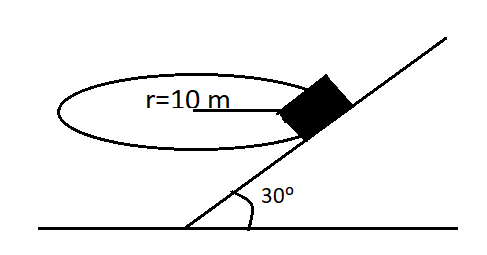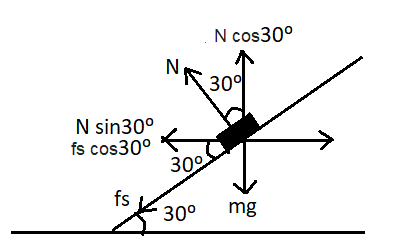
Consider a body of 800 kg moving with a maximum speed $v$ on a road banked at\[\theta = {30^0}\] given \[\cos {30^0} = 0.87\]. Find the normal reaction on the body. Coefficient of friction \[{\mu _s} = 0.2\]. [Take radius, r=10m]
A. 10.4 kN
B. 12.6 kN
C. 11.6 kN
D. 8.3 kN
Answer
217.8k+ views
Hint:When the applied force increases, then the force of friction also increases. The maximum value of static friction is known as limiting friction.
If a body is moving with a maximum speed v on a road banked. Since the circular motion is such that v = vmax the tendency of the body is to move up the inclined plane.
Formula used:
Centripetal force is given as:
\[\dfrac{{m{v^2}}}{r}\]
Where m is the mass of the given body, r is the radius of the circle and v is the maximum speed.
Maximum friction,
\[{f_s} = {\mu _s}N\]
Where \[{\mu _s}\]is the coefficient of friction and N is the normal reaction between the two surfaces.
Complete step by step solution:
Given Coefficient of friction \[{\mu _s} = 0.2\].
Radius of circle, r=10m
\[\cos {30^0} = 0.87\]
Taking g=10m/\[{s^2}\]

In a body force mg is in downward direction and normal reaction is along incline. Here the incline is in \[{30^0}\](in figure). The friction force is along incline and it is at maximum because it moves its maximum speed. Also a centrifugal force acts on it in an outward direction.
Now the normal reaction will be applied perpendicular to the inclined.

Image: Diagram showing resolving components.
After resolving along X axis and Y axis, we have
\[N\cos {30^0} = mg + {f_s}\sin {30^0}\]
As we know, maximum friction \[{f_s} = {\mu _s}N = 0.2N\]
Substituting all the values, we get
\[N\cos {30^0} = mg + {f_s}\sin {30^0}\]
\[\begin{array}{l} \Rightarrow N \cos {30^0} = mg + {f_s}\sin {30^0}\\0.87{\rm{ N = 800}} \times {\rm{10 + 0}}{\rm{.2N}} \times \dfrac{1}{2}\\ \Rightarrow N = \dfrac{{800}}{{0.77}}\\\Rightarrow N {\rm{ = }}10389.6{\rm{ N}}\\ \Rightarrow N {\rm{ = 10400 N}}\\ \therefore N {\rm{ }} \approx {\rm{ 10}}{\rm{.4 kN}}\end{array}\]
Therefore the normal reaction on the body is 10.4 kN.
Hence option A is the correct answer
Note: The banking of roads is the phenomenon in which the outer edges must curve roads above the inner edge to provide the centripetal force to the vehicles so that they can take safe turns.
If a body is moving with a maximum speed v on a road banked. Since the circular motion is such that v = vmax the tendency of the body is to move up the inclined plane.
Formula used:
Centripetal force is given as:
\[\dfrac{{m{v^2}}}{r}\]
Where m is the mass of the given body, r is the radius of the circle and v is the maximum speed.
Maximum friction,
\[{f_s} = {\mu _s}N\]
Where \[{\mu _s}\]is the coefficient of friction and N is the normal reaction between the two surfaces.
Complete step by step solution:
Given Coefficient of friction \[{\mu _s} = 0.2\].
Radius of circle, r=10m
\[\cos {30^0} = 0.87\]
Taking g=10m/\[{s^2}\]

In a body force mg is in downward direction and normal reaction is along incline. Here the incline is in \[{30^0}\](in figure). The friction force is along incline and it is at maximum because it moves its maximum speed. Also a centrifugal force acts on it in an outward direction.
Now the normal reaction will be applied perpendicular to the inclined.

Image: Diagram showing resolving components.
After resolving along X axis and Y axis, we have
\[N\cos {30^0} = mg + {f_s}\sin {30^0}\]
As we know, maximum friction \[{f_s} = {\mu _s}N = 0.2N\]
Substituting all the values, we get
\[N\cos {30^0} = mg + {f_s}\sin {30^0}\]
\[\begin{array}{l} \Rightarrow N \cos {30^0} = mg + {f_s}\sin {30^0}\\0.87{\rm{ N = 800}} \times {\rm{10 + 0}}{\rm{.2N}} \times \dfrac{1}{2}\\ \Rightarrow N = \dfrac{{800}}{{0.77}}\\\Rightarrow N {\rm{ = }}10389.6{\rm{ N}}\\ \Rightarrow N {\rm{ = 10400 N}}\\ \therefore N {\rm{ }} \approx {\rm{ 10}}{\rm{.4 kN}}\end{array}\]
Therefore the normal reaction on the body is 10.4 kN.
Hence option A is the correct answer
Note: The banking of roads is the phenomenon in which the outer edges must curve roads above the inner edge to provide the centripetal force to the vehicles so that they can take safe turns.
Recently Updated Pages
Elastic Collision in Two Dimensions Explained Simply

Elastic Collisions in One Dimension Explained

Electric Field Due to a Uniformly Charged Ring Explained

Electric Field of Infinite Line Charge and Cylinders Explained

Electric Flux and Area Vector Explained Simply

Electric Field of a Charged Spherical Shell Explained

Trending doubts
JEE Main 2026: Application Form Open, Exam Dates, Syllabus, Eligibility & Question Papers

Derivation of Equation of Trajectory Explained for Students

Hybridisation in Chemistry – Concept, Types & Applications

Understanding the Angle of Deviation in a Prism

Understanding Collisions: Types and Examples for Students

How to Convert a Galvanometer into an Ammeter or Voltmeter

Other Pages
JEE Advanced Marks vs Ranks 2025: Understanding Category-wise Qualifying Marks and Previous Year Cut-offs

Units And Measurements Class 11 Physics Chapter 1 CBSE Notes - 2025-26

NCERT Solutions For Class 11 Physics Chapter 8 Mechanical Properties Of Solids

Motion in a Straight Line Class 11 Physics Chapter 2 CBSE Notes - 2025-26

NCERT Solutions for Class 11 Physics Chapter 7 Gravitation 2025-26

Understanding Atomic Structure for Beginners




